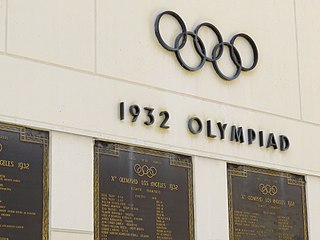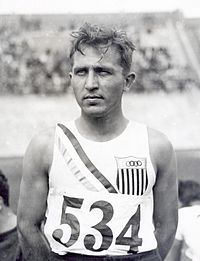
The men's long jump was one of four men's jumping events on the Athletics at the 1964 Summer Olympics program in Tokyo. It was held on 18 October 1964. 37 athletes from 23 nations entered, with 5 not starting in the qualification round. The maximum number of athletes per nation had been set at 3 since the 1930 Olympic Congress. The event was won by Lynn Davies of Great Britain, breaking a string of eight straight American victories. It was Great Britain's first gold medal in the men's long jump, and first medal since 1900. It was only the second time the United States had not won the event, with Sweden's William Petersson in 1920 the only non-American to win before Davies. Ralph Boston of the United States and Igor Ter-Ovanesyan of the Soviet Union became the third and fourth men to win a second medal in the long jump.

The men's long jump at the 1988 Summer Olympics in Seoul, South Korea had a start list of 41 competitors from 31 nations, with two qualifying groups before the final (12) took place on Sunday September 25, 1988. The maximum number of athletes per nation had been set at 3 since the 1930 Olympic Congress.

The men's long jump was an event at the 1956 Summer Olympics in Melbourne, Australia. The qualifying stage and the final both were held on the second day of the track and field competition, on Saturday November 24, 1956. Thirty-two athletes from 21 nations competed. The maximum number of athletes per nation had been set at 3 since the 1930 Olympic Congress. The event was won by Greg Bell of the United States, the nation's seventh consecutive and 12th overall victory in the event. Jorma Valkama's bronze medal was Finland's first medal in the men's long jump.
The men's long jump was an athletics event at the 1996 Summer Olympics in Atlanta, Georgia. There were 54 competitors from 41 nations, with one non-starter. The maximum number of athletes per nation had been set at 3 since the 1930 Olympic Congress. The event was won by Carl Lewis of the United States, the nation's fourth consecutive and 20th overall gold medal in the men's long jump. Lewis himself had won the four straight victories, becoming the third Olympian to win the same event four times in a row as well as the only man to win four long jump medals. It was the ninth and final Olympic gold of Lewis's career. James Beckford earned Jamaica's first medal in the event. Joe Greene matched his bronze from 1992, becoming the ninth two-medal winner in the event.

The men's long jump event was part of the track and field athletics programme at the 1920 Summer Olympics. The competition was held on Tuesday, August 17, 1920, and on Wednesday, August 18, 1920. 29 long jumpers from eleven nations competed. No nation had more than 4 runners, suggesting the limit had been reduced from the 12 maximum in force in 1908 and 1912. The event was won by William Petersson of Sweden, the first time an athlete not from the United States took gold in the long jump.
The men's long jump was an event at the 1992 Summer Olympics in Barcelona, Spain. There were 50 participating athletes from 37 nations, with two qualifying groups. The maximum number of athletes per nation had been set at 3 since the 1930 Olympic Congress. The event was won by Carl Lewis of the United States, the nation's third consecutive and 19th overall gold medal in the men's long jump. Lewis became the second man to win three medals in the event and the first to win three golds. Mike Powell repeated his silver-medal performance from 1988, becoming the eighth two-medal winner in the event. Joe Greene took bronze, completing the United States' second consecutive and fourth overall medal sweep in the men's long jump.

The men's triple jump event at the 1984 Summer Olympics in Los Angeles, California had an entry list of 28 competitors, with two qualifying groups before the final (12) took place on August 4, 1984. The maximum number of athletes per nation had been set at 3 since the 1930 Olympic Congress. The top twelve and ties, and all those reaching 16.60 metres advanced to the final. The event was won by Al Joyner of the United States, the nation's first title in the men's long jump since 1904 and fourth overall. Mike Conley Sr., also an American, took silver. Keith Connor's bronze was Great Britain's first medal in the event since 1908. The Soviet boycott broke that nation's four-Games gold medal and eight-Games podium streaks.

The men's long jump event was part of the track and field athletics programme at the 1924 Summer Olympics. The competition was held on Tuesday, July 8, 1924. 34 long jumpers from 21 nations competed. The maximum number of athletes per nation was 4. The event was won by DeHart Hubbard of the United States, the nation's sixth title in the event. Sverre Hansen won Norway's first long jump medal with the bronze.

The men's triple jump at the 1952 Olympic Games took place on 23 July at the Helsinki Olympic Stadium. Thirty-five athletes from 23 nations competed. The maximum number of athletes per nation had been set at 3 since the 1930 Olympic Congress. Brazilian athlete Adhemar da Silva won the gold medal, breaking the world record twice. It was Brazil's first medal and first victory in the men's long jump. All three of the nations represented on the podium were relatively new to the event in the Olympics; Brazil had sent triple jumpers in 1948, but the Soviet Union and Venezuela each won medals in their first appearance.
The men's long jump event at the 2000 Summer Olympics took place on Monday, 25 September, and Thursday, 28 September 2000, in Sydney, Australia. Fifty-three athletes from 38 nations competed. The maximum number of athletes per nation had been set at 3 since the 1930 Olympic Congress. The event was won by Iván Pedroso of Cuba, the nation's first medal and title in the men's long jump; it snapped a four-Games streak of American victories. Jai Taurima took silver, Australia's third silver in the event. Roman Shchurenko earned Ukraine's first medal in the men's long jump with his bronze. It was the first time the United States had competed in the event and not won at least a silver medal; the Americans had previously failed to place in the top two only at the boycotted 1980 Games.

The men's long jump at the 1980 Summer Olympics in Moscow, Soviet Union had an start list of 32 competitors from 23, with two qualifying groups before the final (12) took place on Monday July 28, 1980. The maximum number of athletes per nation had been set at 3 since the 1930 Olympic Congress. The top twelve and ties and all those reaching 7.90 metres advanced to the final. The event was won by Lutz Dombrowski of East Germany, the first gold medal in the men's long jump by any German jumper. Frank Paschek made East Germany the only nation other than the United States to have two men on the podium in the same Games in the event. Valeriy Podluzhniy won the Soviet Union's first men's long jump medal since 1964. The American-led boycott ended the United States' three-Games gold medal streak and 18-Games streak of winning at least a silver medal in the event.

The men's high jump event at the 1928 Olympic Games took place July 29. Thirty-five athletes from 17 nations competed. The maximum number of athletes per nation was 4. Bob King won the final with a jump of 1.94 metres. Four other competitors cleared 1.91 metres, and their placement was decided via a jump-off. King's victory was the United States' eighth consecutive victory in the men's high jump; Benjamin Hedges's silver made it the third straight Games in which Americans went 1–2. Claude Ménard earned France's second consecutive bronze medal in the event.

The men's long jump event at the 1932 Olympic Games took place August 2. Twelve athletes from 9 nations competed. The 1930 Olympic Congress in Berlin had reduced the limit from 4 athletes per NOC to 3 athletes. The event was won by Ed Gordon of the United States, the nation's third consecutive and eighth overall victory in the long jump.

The men's long jump event was part of the track and field athletics programme at the 1936 Summer Olympics. The competition was held on August 4, 1936. Forty-three athletes from 27 nations competed. The maximum number of athletes per nation had been set at 3 since the 1930 Olympic Congress. The final was won by American Jesse Owens. It was the United States' fourth consecutive and ninth overall gold medal in the event; it was also Owens's second of four gold medals in the 1936 Games. Luz Long won Germany's first medal in the event with silver; Naoto Tajima put Japan on the podium for the second Games in a row with bronze.

The men's triple jump event was part of the track and field athletics programme at the 1936 Summer Olympics. The competition was held on August 6, 1936. Thirty-one athletes from 19 nations competed. The maximum number of athletes per nation had been set at 3 since the 1930 Olympic Congress. The final was won by Naoto Tajima of Japan with a world-record jump. It was Japan's third consecutive gold medal in the men's triple jump; as of the 2016 Games, it is the last gold medal Japan has won in the event. Masao Harada's silver medal made it the second Games in which Japan put two men on the podium in the event. Jack Metcalfe of Australia earned bronze, Australia's first medal in the event since 1924.

The men's long jump field event at the 1960 Olympic Games took place on September 2. Forty-nine athletes from 34 nations competed. The maximum number of athletes per nation had been set at 3 since the 1930 Olympic Congress. The event was won by Ralph Boston of the United States, the nation's eighth consecutive and 13th overall victory in the men's long jump. Igor Ter-Ovanesyan's bronze was the Soviet Union's first medal in the event.

The men's long jump event at the 1976 Summer Olympics in Montreal, Quebec, Canada, had an entry list of 33 competitors from 25 nations, with two qualifying groups before the final (12) took place on Thursday July 29, 1976. The maximum number of athletes per nation had been set at 3 since the 1930 Olympic Congress. The top twelve and ties, and all those reaching 7.80 metres advanced to the final. The qualification round was held in Wednesday July 28, 1976. The event was won by Arnie Robinson of the United States, the nation's third consecutive and 16th overall gold medal in the men's long jump. Randy Williams took silver, but the chance of an American sweep was eliminated when Larry Myricks broke his foot warming up for the final. Robinson and Williams became the fifth and sixth men to earn two medals in the event. Frank Wartenberg of East Germany took bronze.

The men's long jump event at the 1972 Summer Olympics in Munich was held on 8 & 9 of September. Thirty-six athletes from 25 nations competed. The maximum number of athletes per nation had been set at 3 since the 1930 Olympic Congress. The event was won by Randy Williams of the United States, the nation's second consecutive and 15th overall gold medal in the men's long jump. Hans Baumgartner earned West Germany's first medal in the event.

The men's triple jump event at the 1972 Summer Olympics in Munich was held on 3 & 4 of September. Thirty-six athletes from 28 nations competed. The maximum number of athletes per nation had been set at 3 since the 1930 Olympic Congress. The event was won by Viktor Saneyev of the Soviet Union, the fourth man to repeat as Olympic champion in the triple jump. The Soviets were on the podium in the event for the sixth consecutive Games. Jörg Drehmel of East Germany won the first men's triple jump medal by any German jumper. Nelson Prudêncio of Brazil was the ninth man to win a second medal in the event, following up his 1968 silver with bronze in Munich.

The men's long jump at the 1952 Olympic Games took place on July 21 at the Helsinki Olympic Stadium. Twenty-seven athletes from 19 nations competed. The maximum number of athletes per nation had been set at 3 since the 1930 Olympic Congress. American athlete Jerome Biffle won the gold medal. It was the United States' sixth consecutive and 11th overall victory in the men's long jump. Hungary earned its first long jump medal with Ödön Földessy's bronze.

















